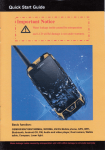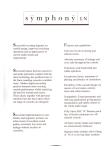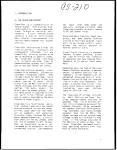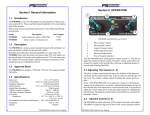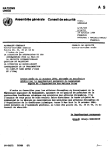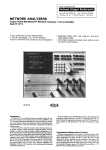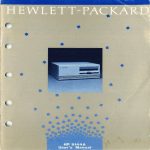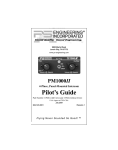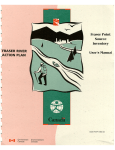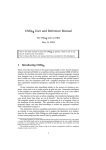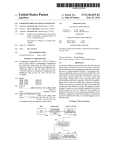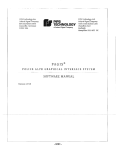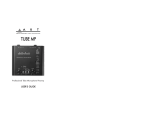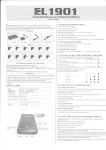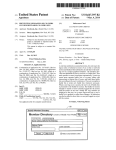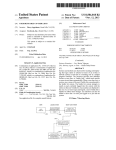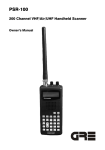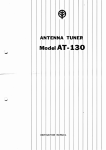Download Pilot`s Guide - mfu-Wien
Transcript
ENGINEERING®
INCORPORATED
sqiljiitQuiiilij:f. Sound·Englneerlng.
9800 Martel Road
Lenoir City, TN 37772
www.ps~engineering.com
PMIOOOII
4-Place, Panel-Mounted Intercom
Pilot's Guide
PaJ1 Number 11920 (with Crew) and 11922 (without Crew)
F AA·J\pprovcd TSO C50c
July 2001
202·123·0001
RevisIon 1
Flying Never Sounded So Good! ™
Section I General Information
1.1
Introduction
The PM 1000//, is an FAA-TSO approved, panell11ounted, 4-pJacc intercom system (lCS). Please read this manual completely to become familiar
wilh all the features.
This manual contains operational instructions for the following PS Engineering units:
Model
PMIOOOlf
PMIOOOlf
1.2
Description
4-place intercom system w/Pilot ISO
Same as above w/intcrnal crew
Part Number
11922
11920
Description
The P:'\'llOOOI/ is a 4-place, panel-mounted intercom with individual volume and squelch cOlltrols for the pilot and copilot.
Both pilot and copilot have transmit capabilities over the radio. The
PMlOOOJ/ allows only the person who presses tbeir PTT to be heard over
the aircrafi radio. If both pilot and copilot press the PTT at the same time,
the copilot will override (Ideally suited for training environments). Pilot
regains priority by switching the unit off.
1.3
Approval Basis
The PM! OOOIl, part numbers 11920 and 11922 are FAA~approved under
TSO-C50c.
1.4
Specifications
Input power:
Currcnt Drain:
Headphone Impedance
Audio Dist011ion:
Aircraft Radio impcdance:
3 dB Mic Frequcncy Rcsponse:
3 dB Music Frequcncy Responsc'
Unit weight:
Dimensions:
13.8 - 27.5 Volts DC
< 250 mA (I Amp Circuit breaker)
150-JOOO ohms typical
<10% @75mWinto 150 n load
10000 typical
350 Hz - 6000 Hz
200 Hz to 15 kHz
12 Ounces (0.342 kg)
Environmental and technical qualitkations.
Temperature
Altitude
2
202-123-0001
1.25" H
x 2.60" W x 5.50" D
(3.2:-:6.6x 14cm)
RTCA DO-160B/DO-170
_20°C to +-55°C
50,000 ft.
PM 1OOOn-Pilot Guide & User Manual
Section II OPERATION
PJH/OOOll with ISO/ALL (pin J 1922)
Pilot Volume Control
2
Pilot Squelch Control
3
Copilol Volume Control
4
Copilot Squelch Control
5
Intercom Mode Switch
6
PowcrfTnmsmit indicator
Turn the PM I00011 on by rotating pilot's volume control (1). This also ellgages the automatic fail-safe system. The pilot's volume control does not
control the volume of the aircrall radio, allo\'\!ing an additional degree or
aircraft radio listening flexibility.
2.1 Adjusting The Volume (1,3)
The pilot's volume control knob (I) adjusts the loudness of the intercom
and music for the pilot's headset only. It has no effect on aircraft radio volume level. The copilot's volume control (3) adjusts the volume for the copilot.
In the I J 920 (PM IOOOIl with Crew) units, the volume level for both pas~
sengers can be adjusted by a screwdriver adjusted potentiometer located on
the left hand side orllle intercom as viewed from the front. It is possible to
adjust the overall output power to the passenger headsets by changing this
potentiometer. Rotating the potentiometer counterclockwise increases the
passenger volume.
2.2
Squelch Control (2, 4)
The PMJOOOlI provides individual VOX circuits for the pilot and copilot.
The ability to adjust the trip level of these VOX circuits (squelch control)
PM I 00011 Pilot Guide & User Manual
202-! 23-000!
allows the use of dissimilar headsets withol\{ the frustration of clipping the
first syllables, The PM1000li has three squelch circuits, one for the pilot,
copilot, and one for the passengers. With individual VOX circuits, background noise is dramatically reduced.
With the engine running, set the squelch c0111rol by slowly rotating the
kJlob(s) (2) and (4) clockwise until YOUllO longer hear the background
noise in the earphones. When the microphone is positioned properly near
the lips, normal speech levels should open the channel. When you have
stopped talking, there is a delay of about one second before the channel
closes. This prevents squelch closure between words, and helps eliminates
choppy intercom conversations.
2.3
Mode Selector (5)
The center switch (5) is a three position mode control that allows the pilot
to tailor the intercom Ji.lJlction to suit flight conditions. Regardless of configuration, the pilot will always hear the aircraft radio. NOTE: If there is a
power failure to the PMIOOOll, or if the power switch is turneo ofC thc
copilot wi!! not bear the aircran radio. Only the pilot is connected directly
to the aircrall radio.
ISO (Up Position): The pilot is isolated from the intercom and is connected
only (0 the aircraft radios. He wi)) hear the aircraft radio reception (and
sidelOne during radio transmissions). Copilot and passcngers will hear
themselves and music but not (he airerafi radio traffic.
ALL (Middle position): All parties will hear the ilircraft radio, transmit
sidetone from radio, intercom, and music. However, during any ICS or
radio communications, the music volume automatically mutes. The music
volume increases gradua1!y back to tbe original level after communications
have been completed.
Units without CREW mode (part !lumber 11922) have a bottom switch
position. This is the same as ALL mode.
I'MIO(J(!/l. JI-'i! I I'J)(I, Fnmll'allcl Control,,'
4
202·123·0001
PM IOOOII-Pilol Guide & User Mallual
CREW (Down PO!:iltion) (ONLY version with crc\\', par! number 11920):
Pilot and copilol arc connected on one illlercom channel, can hear aircraft
radio and transmit sidelone. The passengers arc 011 a separate and independent channel. The pilot and copilot arc connected to the aircraft radio and
may I istcl1 to Music # 1. Passengers can continue to communicate with
themselves without disturbing the pilot and copilot and may listen to Music
#2.
2.3.1
Entertainment Mute Trip Level
The cnte!1ainment mute trip level determines what voluille the aircraft radio
must be belore the music mutes. This is factory adjusted. If your entertainment docs not mute, try increasing the volume of the aircrafl radios.
2.4
Power/Transmit indicator (6)
\}/hcn the PM1000ll is operating, the lamp in the center will glow green.
When either pilot pushes a radio microphone key (push to talk, or P-T-T),
the indicator will change to red. signifying radio transmission.
The aircral't radio sidetone will be presented to the intercom, and heard by
the same people as the aircraft radio receiver audio.
Only the pilot pressing a P~T-T will be heard on the radio, other micro~
phones will be inhibited.
2.5
Fail-safe (1)
If any abnormal conditions OCCllr, such as a loss of radio communication,
bypass the PM J 00011 by placing it in the "fail-safe" mode. When the
PMIOOOlJ is turned 011, either by the pilot volume control (I) or by pulling
the "intercom" circuit breaker, the unit atltomalically enters the fail-safe
mode. In this mode the pilot microphone input is connected to the aircraft
radio output, and the aircraft radio phones input is connected to Ihe pilol
headphone output, enabling pilot radio communication. The copilot and
passenger' stations arc inoperative.
PM I00011 Pilot Guide & User Manual
202-123-000]
5
Section 3
Warranty and Service
3.1
Warranty
In order for the factory warranty to be valid, the installations in a certified
aircraft must be accomplished by an FAA· certified avionics shop and authorized PS Engineering dealer.
PS Engineering, Inc. warranls this product 10 be free from defect in mate·
rial and workmanship for a period orone year 11"om the date of installation.
During this one year warranty period, PS Engineering, Inc., at its option,
will send a replacement unit at our expense if the ullit should be determined
to be defective after consultation with a factory technician. The customer
is responsible lor return shipment costs
This warranty is nOI transferable. Any implied warranties expire at the expiration date ofl11i$ warranty. PS Engineering SHALL NOT BE LIABLE
FOR INCIDENTAL OR CONSEQUENTIAL DAMAGES. This warranty
does not cover a defect that bas resulted from improper or unreasonable use
or maintenance as determined by us. This \varranty is void if there is any
attempt to dissemble this product without factory authorization. This warnUHy gives you specific legal rights, and you may also have other rights
which may vary /l·om state to state. Some states do not allow tbe exclusion
of limitation of incidental or consequential damages, so the above limitation or exclusions may 110t apply to you.
3.2
Factory Service
The »;\-'11000// is covered by a one-year limited warranty. See wammty
information.
The unit is covered by a one-year limited warranty. Sec warranty information. Cal! PS Engineering, Inc. at (865) 988-9800 before you return the
unit. This will allow the service technician 10 provide any other suggestions
for identifying the problem and recommend possible solutions.
6
202·t23·QOOt
PM 1ODOII-Pilot Guide & User Manual
PM I00011 Pilot Guide & User Manual
202·)23·000 I
7
PS EngIneerIng, Inc. 2001 ©
Copyright Notice
Copyrighted illfollnatioll ill thi, manual is subject to change withOl!1 not icc PS Eliginccring
rescrves the light to improve or ehnnge the products or contents of this lllallunl, without
l1otificatiol1 ofRny person or agency The contents of 11115 pilot's guide may be downloaded,
stored and reprinted for personal use provided that this copyright infonnation is included.
COll1mercial usc 15 strictly pl"Ohibitcd. For funher infonnatioll contnct the Publications )I.·tanager
atl'S Engineering, Inc., 9800 lvh\11c1 Rond, Lenoir City, TN 37772. Phone (365) 988·9800
8
202-123-0001
PMl ODOlf-Pilot Guide & User Manual








